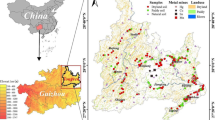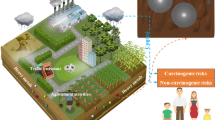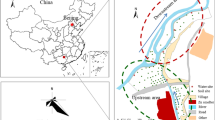Abstract
Large amounts of heavy metal are released by mining and industrial activities to the surrounding environment, raising great concerns regarding the effects of environmental exposure to pollutants on human health. A combination of total and bioaccessible contents, spatial analysis, cluster analysis, and positive matrix factorization model was successfully used to determine the status and sources of heavy metals in a small farmland under long-term influences of mining and industries activities in this study. The results show that the average contents of arsenic (As), cadmium (Cd), lead (Pb), and zinc (Zn) in agricultural soils exceed the Chinese national standard 2.18, 5.95, 3.46, and 1.33 times, respectively. Cd poses the highest potential on human health with a mean geo-accumulation index (Igeo) of 4.51 and a bioaccessible ratio of 37.41%, followed by Pb, which has a mean Igeo of 1.58 and a bioaccessible ratio of 63.24%. The significant correlation (P < 0.01) was found between the total and bioaccessible four contaminated metal contents (As, Cd, Pb, and Zn), indicating that total concentration of heavy metals could be effective indicators on bioaccessibility in this study. The As was attributed to the atmospheric deposition, Cd and Zn were mainly derived from mining activities, and Pb contamination is highly related with cement plant. Compared to atmospheric deposition, industrial activities, and soil parent materials, mining activities has the greatest influence on the enrichments of the total heavy metals in agricultural soils with the proportion of 47.9%.








Similar content being viewed by others
References
Abrahim GMS, Parker RJ (2008) Assessment of heavy metal enrichment factors and the degree of contamination in marine sediments from Tamaki Estuary, Auckland, New Zealand. Environ Monit Assess 136:227–238
Alleman LY, Lamaison L, Perdrix E, Robache A, Galloo JC (2010) PM10 metal concentrations and source identification using positive matrix factorization and wind sectoring in a French industrial zone. Atmos Res 96:612–625
Batayneh AT (2012) Toxic (aluminum, beryllium, boron, chromium and zinc) in groundwater: health risk assessment. Int J Environ Sci Technol 9:153–162
Bhuiyan MAH, Dampare SB, Islam MA, Suzuki S (2014) Source apportionment and pollution evaluation of heavy metals in water and sediments of Buriganga River, Bangladesh, using multivariate analysis and pollution evaluation indices. Environ Monit Assess 187:4075
Boisa N, Elom N, Dean JR, Deary ME, Bird G, Entwistle JA (2014) Development and application of an inhalation bioaccessibility method (IBM) for lead in the PM10 size fraction of soil. Environ Int 70:132–142
Cai L et al (2012) Source identification of eight hazardous heavy metals in agricultural soils of Huizhou, Guangdong Province, China. Ecotox Environ Safe 78:2–8
Calabrese EJ, Stanek EJ, James RC, Roberts SM (1999) Soil ingestion: a concern for acute toxicity in children. Environ Health Perspect 105:1354–1358
Chen R, de Sherbinin A, Ye C, Shi G (2014) China’s soil pollution: farms on the frontline. Science 344:691–692
González-Macías C, Sánchez-Reyna G, Salazar-Coria L, Schifter I (2014) Application of the positive matrix factorization approach to identify heavy metal sources in sediments. A case study on the Mexican Pacific Coast. Environ Monit Assess 186:307–324
Gupta I, Salunkhe A, Kumar R (2012) Source apportionment of PM10 by positive matrix factorization in urban area of Mumbai, India. Sci World J 2012:585791
Hasan AB, Kabir S, Selim Reza AHM, Nazim Zaman M, Ahsan A, Rashid M (2013) Enrichment factor and geo-accumulation index of trace metals in sediments of the ship breaking area of Sitakund Upazilla (Bhatiary-Kumira), Chittagong, Bangladesh. J Geochem Explor 125:130–137
Hu W et al (2018) Source identification of heavy metals in peri-urban agricultural soils of southeast China: an integrated approach. Environ Pollut 237:650–661
Intawongse M, Dean JR (2008) Use of the physiologically-based extraction test to assess the oral bioaccessibility of metals in vegetable plants grown in contaminated soil. Environ Pollut 152:60–72
Jang E, Alam MS, Harrison RM (2013) Source apportionment of polycyclic aromatic hydrocarbons in urban air using positive matrix factorization and spatial distribution analysis. Atmos Environ 79:271–285
Johnson DL, Bretsch JK (2002) Soil lead and children’s blood lead levels in Syracuse, NY, USA. Environ Geochem Health 24:375–385
Juhasz AL, Weber J, Naidu R, Gancarz D, Rofe A, Todor D, Smith E (2010) Determination of cadmium relative bioavailability in contaminated soils and its prediction using in vitro methodologies. Environ Sci Technol 44:5240–5247
Kang Y, Pan W, Liang S, Li N, Zeng L, Zhang Q, Luo J (2016) Assessment of relative bioavailability of heavy metals in soil using in vivo mouse model and its implication for risk assessment compared with bioaccessibility using in vitro assay. Environ Geochem Health 38:1183–1191
Karadaş C, Kara D (2011) In vitro gastro-intestinal method for the assessment of heavy metal bioavailability in contaminated soils. Environ Sci Pollut Res 18:620–628
Kumar A, Ramanathan AL, Prabha S, Ranjan RK, Ranjan S, Singh G (2012) Metal speciation studies in the aquifer sediments of Semria Ojhapatti, Bhojpur District, Bihar. Environ Monit Assess 184:3027–3042
Li ZY, Ma ZW, Kuijp TJVD, Yuan ZW, Huang L (2014) A review of soil heavy metal pollution from mines in China: pollution and health risk assessment. Sci Total Environ 468–469:843–853
Liao J, Wen Z, Ru X, Chen J, Wu H, Wei C (2016) Distribution and migration of heavy metals in soil and crops affected by acid mine drainage: public health implications in Guangdong Province, China. Ecotox Environ Safe 124:460–469
Ljung K, Selinus O, Otabbong E, Berglund M (2006) Metal and arsenic distribution in soil particle sizes relevant to soil ingestion by children. Appl Geochem 21:1613–1624
Ljung K, Oomen A, Duits M, Selinus O, Berglund M (2007) Bioaccessibility of metals in urban playground soils. J Environ Sci Health Part A 42:1241–1250
Lu Y, Yin W, Huang L, Zhang G, Zhao Y (2011) Assessment of bioaccessibility and exposure risk of arsenic and lead in urban soils of Guangzhou City, China. Environ Geochem Health 33:93–102
Martínez CE, Motto HL (2000) Solubility of lead, zinc and copper added to mineral soils. Environ Pollut 107:153–158
Massaquoi LD, Ma H, Liu XH, Han PY, Zuo SM, Hua ZX, Liu DW (2015) Heavy metal accumulation in soils, plants, and hair samples: an assessment of heavy metal exposure risks from the consumption of vegetables grown on soils previously irrigated with wastewater. Environ Sci Pollut Res 22:18456–18468
Mielke HW, Gonzales CR, Smith MK, Mielke PW (1999) The urban environment and children’s health: soils as an integrator of lead, zinc, and cadmium in New Orleans, Louisiana, USA. Environ Res 81:117–129
Muller G (1969) Index of geoaccumulation in sediments of the Rhine River. Geojournal 2:109–118
Paff SW, Bosilovich BE (1995) Use of lead reclamation in secondary lead smelters for the remediation of lead contaminated sites. J Hazard Mater 40:139–164
Pekey H, Doğan G (2013) Application of positive matrix factorisation for the source apportionment of heavy metals in sediments: a comparison with a previous factor analysis study. Microchem J 106:233–237
Poggio L, Vrscaj B, Schulin R, Hepperle E, Ajmone MF (2009) Metals pollution and human bioaccessibility of topsoils in Grugliasco (Italy). Environ Pollut 157:680–689
Schroder JL, Basta NT, Si J, Casteel SW, Evans T, Payton M (2003) In vitro gastrointestinal method to estimate relative bioavailable cadmium in contaminated soil. Environ Sci Tech 37:1365–1370
Schumacher BA (2002) Methods for the determination of total organic carbon (TOC) in soils and sediments. Ecol Risk Assess Supp Center
Tang XY, Cui YS, Duan J, Tang L (2008) Pilot study of temporal variations in lead bioaccessibility and chemical fractionation in some Chinese soils. J Hazard Mater 160:29–36
Tao XQ, Shen DS, Shentu JL, Long YY, Feng YJ, Shen CC (2015) Bioaccessibility and health risk of heavy metals in ash from the incineration of different e-waste residues. Environ Sci Pollut Res 22:3558–3569
Vimercati L et al (2016) Non-occupational exposure to heavy metals of the residents of an industrial area and biomonitoring. Environ Monit Assess 188:673
Wang M, Zheng B, Wang B, Li S, Wu D, Hu J (2006) Arsenic concentrations in Chinese coals. Sci Total Environ 357:96–102
Wang D, Tian F, Yang M, Liu C, Li Y (2009) Application of positive matrix factorization to identify potential sources of PAHs in soil of Dalian, China. Environ Pollut 157:1559–1564
Wang SL, Lin CY, Zhong X (2012) Arsenic content, fractionation, and ecological risk in the surface sediments of lake. Int J Environ Sci Technol 9:31–40
Xue JL, Zhi YY, Yang LP, Shi JC, Zeng LZ, Wu LS (2014) Positive matrix factorization as source apportionment of soil lead and cadmium around a battery plant (Changxing County, China). Environ Sci Pollut Res 21:7698–7707
Yu BM et al (2010) Health risk assessment of abandoned agricultural soils based on heavy metal contents in Hong Kong, the world’s most populated city. Environ Int 36:570–576
Yu L, Cheng J, Zhan J, Jiang A (2016) Environmental quality and sources of heavy metals in the topsoil based on multivariate statistical analyses: a case study in Laiwu City, Shandong Province, China. Nat Hazards 81:1435–1445
Acknowledgements
We gratefully acknowledge the financial support provided by the National Natural Science Foundation of China (Grant no. 41401588).
Author information
Authors and Affiliations
Corresponding author
Electronic supplementary material
Below is the link to the electronic supplementary material.
Rights and permissions
About this article
Cite this article
Xie, W., Peng, C., Wang, H. et al. Bioaccessibility and source identification of heavy metals in agricultural soils contaminated by mining activities. Environ Earth Sci 77, 606 (2018). https://doi.org/10.1007/s12665-018-7783-x
Received:
Accepted:
Published:
DOI: https://doi.org/10.1007/s12665-018-7783-x




